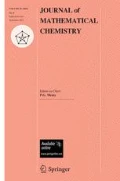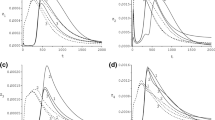Abstract
A mean field model for NO oxidation with H2 over supported catalysts is proposed and solved numerically. The model is composed of a system of PDEs subject to nonclassical conjugate conditions at the catalyst–support interface and includes the bulk diffusion of reactants and reaction products and surface diffusion of all intermediate products. The influence of the particle jumping rate constants via the catalyst–support interface and reaction rate constants on the evolution of the reactivity of the catalyst surface is investigated. It is shown that the conversion rates (turnover frequencies) of NO and H2 into products, N2, H2O, NH3, and N2O, are nonmonotonous functions of time. The conversion rates of NO and H2 into N2 and N2O can have one or two local maxima, while their conversion rates into H2O and NH3 can possess one, two, or three local maxima. The mechanism and conditions for arising of the second maximum are discussed and reaction steps that essentially increase the surface reactivity are indicated.





Similar content being viewed by others
References
W.C. Egelhoff Jr., The Chemical Physics of Solid Surfaces and Heterogeneous Catalysis, in Fundamental Studies of Heterogeneous Catalysis, vol. 4, ed. by D.A. King, D.P. Woodruff (Elsevier, Amsterdam, 1982)
K.C. Taylor, Automotive Catalytic Converters (Springer, Berlin, 1984)
V.P. Zhdanov, Monte Carlo simulations of oscillations, chaos and pattern formation in heterogeneous catalytic reactions. Surf. Sci. Rep. 45, 231–326 (2002)
M.W. Lesley, L.D. Schmidt, The NO + CO reaction on Pt(100). Surf. Sci. 155, 215–240 (1985)
H.H. Madden, R. Imbihl, Interaction of NO and H2 with Pt(100). Appl. Surf. Sci. 48(49), 130–134 (1991)
J. Siera, P. Cobden, K. Tanaka, B.E. Nieuwenhuys, The NO–H2 reaction over Pt(100) oscillatory behaviour of activity and selectivity. Catal. Lett. 10, 335–342 (1991)
M.F.H. van Tol, A. Gielbert, B.E. Nieuwenhuys, Oscillatory behaviour of the reduction of NO by H2 over Rh. Catal. Lett. 16, 297–309 (1992)
J. Siera, Ph.D. thesis, Leiden university, The Nederlands (1992)
P.D. Cobden, J. Siera, B.E. Nieuwenhuys, Oscillatory reduction of nitric oxide with hydrogen over Pt(100). J. Vac. Sci. Technol. A10, 2487 (1992)
S.J. Lombardo, M. Slinko, T. Fink, T. Loher, H.H. Madden, R. Imbihl, G. Ertl, The NO + H2 and NO + NH3 reactions on Pt(100): steady state and oscillatory kinetics. Surf. Sci. 269(270), 481–487 (1992)
M.M. Slinko, T. Fink, T. Loher, H.H. Madden, S.J. Lombardo, R. Imbihl, G. Ertl, The NO + H2 reaction on Pt(100): steady state and oscillatory kinetics. Surf. Sci. 264, 157–170 (1992)
D.Y. Zemlyanov, M.Y. Smirnov, V.V. Gorodetskii, J.H. Block, HREELS and TDS studies of NO adsorption and NO+H2 reaction on Pt(100) surfaces. Surf. Sci. 329, 61–70 (1995)
B. Rausenberger, M. Mundschau, W. Swiech, W. Engel, A.M. Bradshaw, Investigation of the NO + H2 reaction on Pt100 with low-energy emission and reflection microscopy: PEEM studies. J. Chem. Soc., Faraday Trans. 92, 2941 (1996)
S.J. Lombardo, T. Fink, R. Imbihl, Simulations of the NO+NH3 and NO+H2 reactions on Pt(100): steady state and oscillatory kinetics. J. Chem. Phys. 98, 5526 (1993)
M.M. Slinko, N.I. Jaeger, Oscillating Heterogeneous Catalytic Systems (Elsevier, Amsterdam, 1994)
M. Gruyters, A.T. Pasteur, D.A. King, Simulation of oscillatory behaviour in the reduction of NO by hydrogen on Pt100: the role of non-linear restructuring. J. Chem. Soc. Faraday Trans. 92, 2941 (1996)
A.G. Makeev, B.E. Nieuwenhuys, Mathematical modeling of the NO+H2/Pt(100) reaction: “Surface explosion,” kinetic oscillations, and chaos. J. Chem. Phys. 108, 3740 (1998)
A.G. Makeev, B.E. Nieuwenhuys, Simulation of oscillatory behaviour in the NO+H2 reaction on a partially reconstructed Pt(100) surface. Surf. Sci. 418, 432–440 (1998)
F. Zaera, C.S. Gopinath, Role of adsorbed nitrogen in the catalytic reduction of NO on rhodium surfaces. J. Chem. Phys. 111, 8088–8097 (1999)
A.G. Makeev, M. Hinz, R. Imbihl, Modeling anisotropic chemical wave patterns in the NO+H2 reaction on a Rh(110) surface. J. Chem. Phys. 114, 9083 (2001)
Y. De Decker, F. Baras, N. Kruse, G. Nicolis, Modeling the NO+H2 reaction on a Pt field emitter tip: mean-field analysis and Monte Carlo simulations. J. Chem. Phys. 117, 10244 (2002)
F.V. Caballero, L. Vicente, A simulation of oscillatory behavior in the NO+H2 reaction on Pt(100): effect of diffusion and blocking sites. Chem. Eng. Sci. 58, 5087–5102 (2003)
F.V. Caballero, L. Vicente, Coupled diffusion on the reaction on Pt(1 0 0): chemical wave pattern formation by defects. Chem. Eng. J. 106, 229–240 (2005)
L. Vicente, F.V. Caballero, Modeling of surface explosion of reaction on Pt(1 0 0): mean-field analysis and dynamic Monte Carlo simulations. J. Mol. Catal. A Chem. 272, 118–127 (2007)
D.D. Hibbitts, R. Jimenez, M. Yoshimura, B. Weiss, E. Iglesia, Catalytic NO activation and NO–H2 reaction pathways. J. Catal. 319, 95–104 (2014)
R. Imbihl, G. Ertl, Oscillatory kinetics in heterogeneous catalysis. Chem. Rev. 95, 697–733 (1995)
N.M.H. Jansen, P.D. Cobden, B.E. Niewenhuys, Non-linear behaviour of nitric oxide reduction reactions over metal surfaces. J. Phys. Condens. Matter. 9, 1889–1917 (1997)
T.V. Bocarme, N. Kruse, Kinetic instabilities during the NOx reduction with hydrogen on Pt crystals studied with field emission on the nanoscale. Chaos 12, 118–130 (2002)
D.Y. Zemlyanov, M.Y. Smirnov, V.V. Gorodetskii, NO adsorption on reconstructed and unreconstructed Pt(100) surface at 300 K TDS studies. React. Kinet. Catal. Lett. 53, 87–95 (1994)
V.P. Zhdanov, B. Kasemo, Monte Carlo simulation of oscillations in the NO–H2 reaction on Pt (1 0 0). Appl. Catal. A 187, 61–71 (1999)
V.P. Zhdanov, Surface restructuring, kinetic oscillations, and chaos in heterogeneous catalytic reactions. Phys. Rev. E 5(9), 6292–6305 (1999)
V.P. Zhdanov, Surface restructuring and kinetic oscillations in heterogeneous catalytic reactions. Phys. Rev. E 60, 7554–7558 (1999)
V.P. Zhdanov, B. Kasemo, Standing fronts in bistable reactions on composite catalytic surfaces. Phys. Rev. B 62, R4849–R4852 (2000)
V.P. Zhdanov, B. Kasemo, Standing fronts in oscillatory reactions on composite catalytic surfaces. Physica D 151, 73–81 (2001)
V. Skakauskas, P. Katauskis, Modelling of the “surface explosion” of the NO+H2 reaction over supported catalysts. J. Math. Chem. 58, 1531–1547 (2020)
A.N. Gorban, H.P. Sargsyan, H.A. Wahab, Quasichemical models of multicomponent nonlinear diffusion. Math. Model. Nat. Phenom. 6, 184–262 (2011)
A.A. Samarskii, The Theory of Difference Schemes (Marcel Dekker, New York, 2001)
R. Čiegis, P. Katauskis, V. Skakauskas, The robust finite-volume schemes for modeling nonclassical surface reactions. Nonlinear Anal. Model. Control 23, 234–250 (2018)
W. Hundsdorfer, J.G. Verwer, Numerical Solution of Time-Dependent Advection-Diffusion-Reaction Equations, Springer Series in Computational Mathematics, vol. 33. (Springer, Berlin, 2003).
Th. Fink, J.P. Dath, M.R. Basset, R. Imbihl, G. Ertl, The mechanism of the “explosive” NO + CO reaction on Pt(100): experiments and mathematical modeling. Surf. Sci. 245, 96–110 (1991)
Acknowledgements
This work was supported by the Research Council of Lithuania (Project No. S-MIP-17-65).
Author information
Authors and Affiliations
Corresponding author
Additional information
Publisher's Note
Springer Nature remains neutral with regard to jurisdictional claims in published maps and institutional affiliations.
Rights and permissions
About this article
Cite this article
Skakauskas, V., Katauskis, P. Modelling reduction of nitric oxide by hydrogen over supported catalysts. J Math Chem 59, 1456–1473 (2021). https://doi.org/10.1007/s10910-021-01248-0
Received:
Accepted:
Published:
Issue Date:
DOI: https://doi.org/10.1007/s10910-021-01248-0




